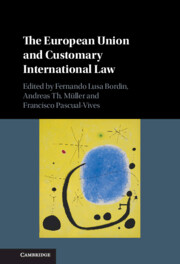Book contents
- The European Union and Customary International Law
- The European Union and Customary International Law
- Copyright page
- Contents
- Contributors
- Acknowledgements
- Cases
- Treaties
- Abbreviations
- Introduction
- Part I A View from the Outside
- Part II Looking in Between
- Part III A View from the Inside
- 7 Customary International Law in the European Union Legal System
- 8 The Direct Effect of Customary International Law
- 9 Customary International Law in the European Union Legal System
- 10 Customary International Law as a Source of European Union Law
- Index
8 - The Direct Effect of Customary International Law
The ‘Treaty Analogy’ and Its Limits
from Part III - A View from the Inside
Published online by Cambridge University Press: 27 October 2022
- The European Union and Customary International Law
- The European Union and Customary International Law
- Copyright page
- Contents
- Contributors
- Acknowledgements
- Cases
- Treaties
- Abbreviations
- Introduction
- Part I A View from the Outside
- Part II Looking in Between
- Part III A View from the Inside
- 7 Customary International Law in the European Union Legal System
- 8 The Direct Effect of Customary International Law
- 9 Customary International Law in the European Union Legal System
- 10 Customary International Law as a Source of European Union Law
- Index
Summary
One important aspect of the legal effects of CIL within the EU legal order concerns the questions of whether CIL can be relied upon in EU law-related administrative or judicial proceedings and, correspondingly, whether administrative and judicial authorities are obliged to apply CIL in such proceedings in order to decide the case at hand. This is the problem of the ‘invocability’, ‘enforceability’ or the ‘direct effect’ of EU law. As there has so far only been marginal treatment of the direct effect of CIL (as opposed to that of international agreements), the chapter aims at clarifying whether and to what extent the solutions devised for the direct effect of international agreements can be transferred to CIL, that is, whether the ‘treaty analogy’ holds. In this regard, the chapter pleads not only for a uniform direct effect test for international agreements and CIL norms, but for a uniform direct effect analysis for all provisions of EU law, internal and external alike. The chapter further argues that the existing differences among the various types of EU law norms as well as the specificities of each individual provision can be adequately dealt with by applying a context-sensitive analysis of the respective provision of EU law.
Keywords
- Type
- Chapter
- Information
- The European Union and Customary International Law , pp. 210 - 239Publisher: Cambridge University PressPrint publication year: 2022



